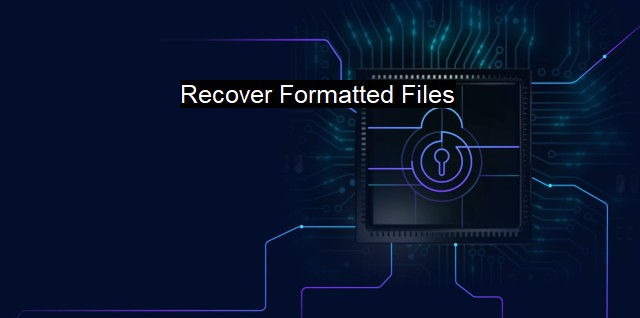What are Recover Formatted Files?
Data Recovery: Navigating the Risks of Digital Storage in a Fast-Paced World
Recover Formatted Files is a closely associated term within the realms of cybersecurity and antivirus. it refers to the process of retrieving data files from a storage device after they have been erroneously deleted or systematically wiped out due to formatting.Cybersecurity, the practice of securing systems and networks from digital attacks, offers several advantages including managing accessibility and reversing unauthorized changes. Part of this proactive protection is the process of data recovery, a crucial capability that lets you recover files that were accidentally erased or corrupted due to various kinds of digital threats. One of these recovery procedures is the recovery of formatted files.
A formatted file is a categorical way of describing a file that has been systematically deleted from a system storage due to formatting. A device is often formatted for various reasons such as infestation by malware or viruses, system upgrades or system performance optimization.
During formatting, files in a system are not completely erased as most people would imagine. Thus, file recoverability is strongly guarded over by cybersecurity. Instead of total eradication, the storage space that the file occupied is marked as reusable, and the file is deleted from the system directory. This renders the file invisible to a typical user but doesn’t mean total loss, as the file remains intact within the system storage until it is overwritten by new data.
This brings us back to the theme of Recover Formatted Files. It is a predominant cybersecurity procedure that facilitates the retrieval of seemingly vanished files coming after a system storage gets formatted. Its success rate largely depends on how quickly the recovery attempt takes place after the deletion ensued. The more the time elapses, the higher chances the original data gets overwritten by new data, thus making recovery more tormented.
It requires specialized software tools, mostly part of sturdy antivirus programs or exclusive data recovery applications, to effectively recover formatted files. These tools function on the premise that the data of a deleted file usually remains on the hardware long after it has been erased, giving a plausible chance for recovery.
Data experts and different antivirus solutions use varying recovery algorithms depending on the complexity, but usually follow a common approach involving scanning, previewing, and file recovery. The selected recovery program scans the device deeply to identify traces of lost files. This is a systematic, often time-consuming process that checks each sector of the storage to ensure no bit is left unchecked. Post scanning, users can preview lost files that the software managed to locate, aiding in selectively identifying crucial documents. the recovery option brings the lost data back to life.
Considering the cyber threats posed by viruses and malware that may force an inevitable format or attracts inadvertent mistakes leading to file deletion, the ability to recover such files holds immense importance in cybersecurity niches. Hence, antivirus software often comes equipped with data recovery features or compatibility.
Being conscious of meticulous file handling, effectual antivirus protection, and regular data backups can improve data security considerably and decrease dependencies on data recovery procedures. But in case the files get formatted intentionally or unintentionally, knowing that it's possible to perform formatted file recovery offers peace of mind and an essential safety net in the digital ecosystem. This is just another tool in the toolkit for those advocating for robust cybersecurity measures. The security of data, indeed, depends a lot on the swift recovery of such formatted files.
Resilient cybersecurity not only protects but equips mechanisms to repair and recover. It provides a glimmer of hope in otherwise devastating scenarios, showing us how far the realm of cybersecurity and antivirus has truly come. Thus, the ability to Recover Formatted Files perpetuates confidence in the unflappable fortitude of today's digital security measures.

Recover Formatted Files FAQs
What are formatted files in cybersecurity?
Formatted files refer to data that has been erased from a storage device using the formatting function. This process wipes all data from the storage device, which makes it appear as though the space is empty.How can I recover formatted files?
You can use data recovery software to recover formatted files. These programs can scan the drive to locate the formatted data and restore it.Can antivirus software help recover formatted files?
Antivirus software is not specifically designed for recovering formatted files. However, some antivirus programs do come with data recovery capabilities. You may want to check with your antivirus vendor to see if they offer a recovery feature.Is it possible to recover all formatted files?
It depends on how extensively the data has been overwritten. If the storage device has been used heavily since the formatting, then some of the data may be permanently lost. However, if the device has not been used much, then most of the data should be recoverable.| | A | | | B | | | C | | | D | | | E | | | F | | | G | | | H | | | I | | | J | | | K | | | L | | | M | |
| | N | | | O | | | P | | | Q | | | R | | | S | | | T | | | U | | | V | | | W | | | X | | | Y | | | Z | |
| | 1 | | | 2 | | | 3 | | | 4 | | | 7 | | | 8 | | |||||||